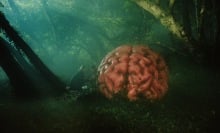Have you ever felt so alienated from your world that only the folklore of wild things could soothe you? In the opening of The Outrun, a young woman named Rona (played by four-time Academy Award nominee Saoirse Ronan) shares the legend of the selkie. Through a dreamy voiceover, she explains how these mythological shapeshifters of the sea could come ashore at night, shed their seal skins, and dance in the guise of humans on the sand and rock. But should they be seen by humans, they'd be trapped to live on the soil, discontent the rest of their days. Rona, an alcoholic struggling with sobriety, can relate, having had her fair share of scandalous revels and scorching disappointments.
Based on the 2016 memoir of the same name by British journalist Amy Liptrot, The Outrun follows a deeply personal tale of self-love, loss, and addiction, weaving in elements of science, folklore, and animation to profound effect. Determined to get sober, Rona returns to her hometown, the Orkney Islands off the coast of Scotland, to reconnect with her parents and herself.
Director Nora Fingscheidt, who co-wrote the adapted screenplay with Liptrot, plays with Rona's timeline, leaping to dark days past, bright days present, and all the grays in between with abandon and aplomb. (What results is far better than another buzzed-about drama out of the UK, We Live in Time, starring Ronan's sister in Little Women, Florence Pugh!) Altogether, these elements weave a familiar tale of a rocky road with a distinctive character that makes the story impossible to ignore.
Saorsie Ronan is fearless in The Outrun.

Rona has many sides to her, and Ronan captures them all with commitment and empathy. The film follows this twentysomething across a blooming romance with a dashing beau named Daynin (Paapa Essiedu), belligerent nights of havoc and violence, cheery quality time with her friendly father (Stephen Dillane), abrasive verbal battles with her concerned mother (Saskia Reeves), and cozy moments of advocating for animal rights. (This last bit includes performances from non-professional actors, giving The Outrun a crisp authenticity.)
Through all this, Ronan not only has the tricky challenge of playing drunk realistically, but also must veer from warm charm to ruthless wrath, connecting all these disparate bits to make Rona whole. In a masterfully measured performance, her physicality shifts from volatile and loose to relaxed to furtive. Always, she offers a body language clue as to where her character is in this journey, as the scenes skip forward and back in time.
Helping the viewer connect all of these pieces is the aforementioned voiceover, with Ronan's voice calmly allowing us into Rona's various intellectual curiosities. Wondering aloud on nature and myth, Ronan subtly seeks to find where her more feral side fits into a polite society. Fingscheidt welcomes us into Rona's perspective by illustrating her intellectual tangents; for instance, unfurling beautiful footage of seals swimming around a beach. The handheld camera gives a purposefully wobbly portrait of the world, reflecting Rona's struggle to get a grip. Elsewhere, the director allows the music that pumps from Rona's headphones to overtake the audio of the film, welcoming us into the bliss of the all-consuming beat. Yet the most effective device that Fingscheidt employs is the time-jumping.
The Outrun's temporal leaps throw you into the hardships of recovery.

Where in We Live in Time, flashbacks to flash-forwards made for a story too slippery to hold onto, here, following just one protagonist who is often lost in her own world, it works. One simple visual cue is Fingscheidt's nod to then-versus-now through Rona's hair. One phase is defined by a rosy pink bob, another by hair dyed fully blue, another with pale blonde locks with blue tips, or all blonde, or the pink-orange of a sunrise. These are elegant indicators of then and now. But the flow of the story is more about Rona's experience.
Progress — as any worthwhile therapist will tell you — is never a straight line. The Outrun's non-linear approach reflects that by throwing us back and forth in Rona's recovery. This can make her story initially hard to parse. Why is she angry with her mother but close to her dad? But the mindful script eventually reveals all we need to understand her relationships. More telling, this willfully jarring back and forth reflects Rona's journey, one step forward, two steps back, and so on. A good day might be followed by a dark temptation, which pitches us back into a memory of a low point. And through this, the unpredictability of addiction is expressed. As Rona says, "The urge to drink can come out of nowhere. You think you're doing well. Suddenly you want nothing more than a drink." The sophisticated pacing of The Outrun urges audience empathy by putting us in her dizzying whirl of emotions, doubt, desire, hope, and regret.

Surrounded by a solid supporting cast, Ronan ably shoulders a messy tale of substance abuse and survival. Liptrot and Fingscheidt's script neatly builds a story unconventional yet comprehensive. The editing from Stephan Bechinger smartly keeps the audience off-balance but not out of their depths. Fingscheidt's vision for weaving Rona's perspective into cinematography, sound design, narration, and visual tangents that include animation, makes for a movie that feels achingly personal, yet universal in its humanity. Simply put, The Outrun is an emotionally intelligent drama that soars, thanks to the glorious collaboration between the writers, the filmmaker, and the movie's radiant leading lady.
The Outrun opens in theaters Oct. 4.
Topics Film











